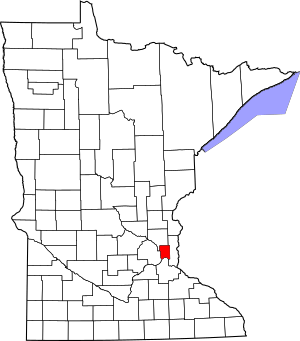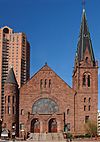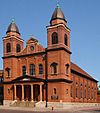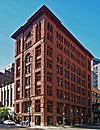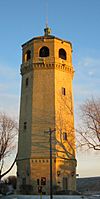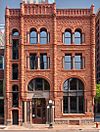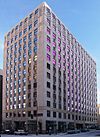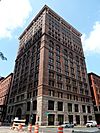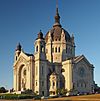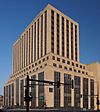National Register of Historic Places listings in Ramsey County, Minnesota facts for kids
This is a list of cool historic places in Ramsey County, Minnesota, that are on the National Register of Historic Places! Think of it like a special list of important buildings, areas, and landmarks that are protected because they tell us a lot about history. If you look at the map, you can see where Ramsey County is in Minnesota.
There are 124 places in Ramsey County on this list. Three of them are even more special and are called National Historic Landmarks! There are also a few places that used to be on the list but aren't anymore.
Contents
A Look Back at Ramsey County's History
Ramsey County is in the southeastern part of Minnesota. It's bordered by the Mississippi River in some spots, and by other counties like Hennepin, Anoka, Washington, and Dakota. The main city in Ramsey County is Saint Paul, which is also the capital of Minnesota! Even the "West Side" of Saint Paul, which is south of the Mississippi River, is part of Ramsey County.
The historic places in Ramsey County include all sorts of buildings. There are old houses, churches, schools, and places where people used to shop or work. You'll also find community centers and important structures like bridges. Some of the oldest buildings in Minnesota are right here in Ramsey County. These show us where the first non-Native American settlers lived.
Saint Paul became a very important city because it was the northernmost natural port on the Upper Mississippi River. This meant lots of goods and people traveled through Saint Paul by river and later by train. Even though Minneapolis (in Hennepin County) grew to be bigger in terms of business, Saint Paul stayed important as the state capital. Government jobs and services kept the county growing. Many of these historic sites are connected to the different groups of immigrants who came to Ramsey County, like people from Germany, Czech Republic, and Scandinavia. These groups made up most of the residents for the first 100 years of the county's history.
Amazing Places You Can Still See Today
| Name on the Register | Image | Date listed | Location | City or town | Description | |
|---|---|---|---|---|---|---|
| 1 | 3M Administration Building |
(#14001212) |
777 Forest Street 44°57′53″N 93°03′46″W / 44.964632°N 93.062729°W |
Saint Paul | This building was the main office for the company 3M from 1940 to 1962. It's a great example of Moderne style and shows how successful the company became through new ideas and products. | |
| 2 | Arlington Hills Library |
(#84001660) |
1105 Greenbrier Street 44°58′28″N 93°04′16″W / 44.974444°N 93.071111°W |
Saint Paul | One of three beautiful Beaux-Arts style Carnegie libraries built in Saint Paul between 1916 and 1917. These libraries were very important for education in the city. | |
| 3 | John M. Armstrong House |
(#83000925) |
225 Eagle Parkway 44°56′28″N 93°06′03″W / 44.941111°N 93.100833°W |
Saint Paul | An early and fancy house designed by architect Edward Bassford in 1886. It's the only semi-detached (two houses sharing a wall) house left in downtown Saint Paul from that time. | |
| 4 | Assumption School |
(#75001005) |
68 Exchange Street 44°56′51″N 93°06′00″W / 44.9475°N 93.1°W |
Saint Paul | This was an early church school, open from 1864 to 1888. It taught children from the mostly German immigrant families of the Church of the Assumption. It's also known for its cool limestone Italian Villa style. | |
| 5 | Dr. Ward Beebe House |
(#77000762) |
2022 Summit Avenue 44°56′28″N 93°11′09″W / 44.941111°N 93.185833°W |
Saint Paul | A house built in 1912 that shows the Prairie School style used by architects Purcell & Elmslie in the area. It's also part of the West Summit Avenue Historic District. | |
| 6 | Blair Flats |
(#75001006) |
165 Western Avenue 44°56′47″N 93°06′58″W / 44.946389°N 93.116111°W |
Saint Paul | A very stylish Victorian apartment building from 1887, built for businessman Frank P. Blair. It's also part of the Historic Hill District. | |
| 7 | Bridges No. L-5853 and 92247 |
(#89001842) |
Lexington Avenue in Como Park 44°58′42″N 93°08′47″W / 44.978333°N 93.146389°W |
Saint Paul | These are Minnesota's second-oldest reinforced-concrete arch bridges. They were designed in 1904 using a new building system. | |
| 8 | Markell and Edward Brooks, Sr. House |
(#00000689) |
176 Mississippi River Boulevard North 44°56′47″N 93°11′54″W / 44.946389°N 93.198333°W |
Saint Paul | A great example of a 1920s Colonial Revival estate. Today, it's called Eastcliff and is the official home of the University of Minnesota system president. | |
| 9 | Benjamin Brunson House |
(#75001007) |
485 Kenny Rd. 44°57′27″N 93°04′48″W / 44.9575°N 93.08°W |
Saint Paul | This 1855 Federal style house belonged to Benjamin Brunson, who was a very important early leader and helped start Saint Paul. | |
| 10 | Casiville Bullard House |
(#96001559) |
1282 Folsom Street 44°58′48″N 93°07′57″W / 44.979917°N 93.132417°W |
Saint Paul | A 1909 house built by Casiville Bullard, a skilled stonemason and bricklayer. He was one of the few talented African Americans working in construction in Saint Paul in the early 1900s. | |
| 11 | Burbank-Livingston-Griggs House |
(#70000307) |
432 Summit Avenue 44°56′27″N 93°07′06″W / 44.940863°N 93.118358°W |
Saint Paul | This 1863 limestone house is one of Minnesota's best examples of the fancy mid-19th-century Italianate style. It's also part of the Historic Hill District. | |
| 12 | Pierce and Walter Butler House |
(#82004625) |
1345–1347 Summit Avenue 44°56′31″N 93°09′26″W / 44.941942°N 93.157204°W |
Saint Paul | A unique double house built in 1900 for brothers Pierce Butler (who became a U.S. Supreme Court justice) and Walter Butler (a major builder). It's also part of the West Summit Avenue Historic District. | |
| 13 | C.S.P.S. Hall |
(#77000763) |
381–383 Michigan Street 44°56′07″N 93°06′58″W / 44.935278°N 93.116111°W |
Saint Paul | This 1887 building was a meeting hall for the Czech-Slovak Protective Society, serving Saint Paul's small but active Czech American community. | |
| 14 | Central Presbyterian Church |
(#83000926) |
500 Cedar Street 44°56′59″N 93°05′46″W / 44.949722°N 93.096111°W |
Saint Paul | One of Saint Paul's biggest and best Richardsonian Romanesque churches, built from 1888 to 1890. It's one of the few churches designed by architect Warren H. Hayes in Saint Paul. | |
| 15 | Church of St. Agnes-Catholic |
(#80002125) |
548 Lafond Avenue 44°57′35″N 93°07′24″W / 44.959722°N 93.123333°W |
Saint Paul | A famous Baroque Revival church built from 1901 to 1912 for a community of immigrants from Austria-Hungary. | |
| 16 | Church of St. Bernard-Catholic |
(#83000927) |
197 Geranium Avenue West 44°58′33″N 93°06′28″W / 44.975867°N 93.107766°W |
Saint Paul | This church, built from 1905 to 1914, is known for its new Prairie School and Art Nouveau design. It was also built with early reinforced-concrete, and is a masterpiece by architect John Jager. | |
| 17 | Church of St. Casimir-Catholic |
(#83000939) |
937 Jessamine Avenue East 44°58′30″N 93°03′40″W / 44.975°N 93.061111°W |
Saint Paul | A 1904 Beaux-Arts style church built for a Polish immigrant community. | |
| 18 | Church of the Assumption-Catholic |
(#75001008) |
51 9th Street West 44°56′51″N 93°05′57″W / 44.9475°N 93.099167°W |
Saint Paul | This Romanesque Revival church was built from 1870 to 1874 for a German immigrant community. It's based on a famous church in Munich, Germany. | |
| 19 | Cyrus B. Cobb House |
(#83000928) |
2199 1st Street 45°04′57″N 93°00′28″W / 45.082565°N 93.007877°W |
White Bear Lake | An 1885 Queen Anne style house. It's one of the oldest brick houses from the Victorian era still standing in White Bear Lake. | |
| 20 | Colorado Street Bridge |
(#90000977) |
East side of South Wabasha Street near Terrace Park 44°56′05″N 93°05′03″W / 44.934722°N 93.084167°W |
Saint Paul | This is a unique 1888 skew arch bridge. At 70 feet long, it was the longest stone arch bridge on a Minnesota highway. It's now used only by people walking. | |
| 21 | Commerce Building |
(#07000645) |
8 Fourth Street East 44°56′42″N 93°05′36″W / 44.944873°N 93.093296°W |
Saint Paul | An office building from 1912 that was the main office for two business groups. It shows how important business networking was for Saint Paul's growth in the late 1800s and early 1900s. | |
| 22 | Como Park Conservatory |
(#74001033) |
Como Park 44°58′53″N 93°09′03″W / 44.981389°N 93.150833°W |
Saint Paul | A beautiful glass and steel botanical conservatory built in 1914–1915, where you can see many different plants. | |
| 23 | William and Catherine Davern Farm House |
(#83003765) |
1173 Davern Street South 44°54′22″N 93°10′22″W / 44.90618°N 93.172721°W |
Saint Paul | A rare old Italianate style farmhouse from one of Saint Paul's first farming families, built around 1862. | |
| 24 | Derham Hall and Our Lady of Victory Chapel, College of Saint Catherine |
(#85003423) |
2004 Randolph Avenue 44°55′32″N 93°11′04″W / 44.925556°N 93.184444°W |
Saint Paul | These are the oldest buildings at St. Catherine University, with a hall from 1903 and a Romanesque Revival chapel from 1923. | |
| 25 | Euclid View Flats |
(#13001170) |
234–238 Bates Avenue 44°57′14″N 93°03′59″W / 44.953834°N 93.066306°W |
Saint Paul | An early apartment building from 1894–1895, designed to be nice for middle-class families. It mixes Queen Anne and Romanesque Revival styles. | |
| 26 | Finch, Vanslyck, and McConville Dry Goods Company Building |
(#82004626) |
366 Wacouta Street 44°56′59″N 93°05′13″W / 44.949722°N 93.086944°W |
Saint Paul | A big warehouse built in 1911 (and made bigger in 1923). It shows how important the wholesaling (selling goods in bulk) business was in Saint Paul. It's also part of the Lowertown Historic District. | |
| 27 | First Baptist Church of Saint Paul |
(#83000929) |
499 Wacouta Street 44°57′09″N 93°05′25″W / 44.9525°N 93.090139°W |
Saint Paul | A fancy 1874 Gothic Revival church designed by William W. Boyington. It was built for Minnesota's oldest Baptist church group in an area that has changed a lot since then. | |
| 28 | First National Bank of White Bear |
(#83000930) |
4744 Washington Avenue 45°05′05″N 93°00′32″W / 45.084741°N 93.0088°W |
White Bear Lake | This 1921 Neoclassical bank building is the most impressive early business building in White Bear Lake. It was key to the town growing from a resort to a city. | |
| 29 | F. Scott Fitzgerald House |
(#71000440) |
599 Summit Avenue 44°56′30″N 93°07′31″W / 44.941528°N 93.125139°W |
Saint Paul | This is the house where famous author F. Scott Fitzgerald lived with his parents from 1919 to 1920. He wrote his first published novel, This Side of Paradise, here! It's also part of the Historic Hill District. | |
| 30 | Fitzpatrick Building |
(#90001113) |
465–467 Wabasha Street North 44°56′53″N 93°05′50″W / 44.948194°N 93.097222°W |
Saint Paul | A well-preserved example of a Queen Anne style business building from Saint Paul's busy 1880s and 1890s. | |
| 31 | Foss House |
(#83000931) |
321 Silver Lake Rd. SW 45°02′40″N 93°13′02″W / 45.044498°N 93.217359°W |
New Brighton | A large Victorian house built around 1896 for an early family who settled in the countryside outside New Brighton. | |
| 32 | Germania Bank Building |
(#77000764) |
6 5th Street West 44°56′44″N 93°05′41″W / 44.945491°N 93.094593°W |
Saint Paul | An 1889 office building designed by J. Walter Stevens and Harvey Ellis. It's Saint Paul's only remaining brownstone skyscraper. | |
| 33 | Heman Gibbs Farmstead |
(#75001009) |
2097 Larpenteur Avenue 44°59′32″N 93°11′18″W / 44.992222°N 93.188333°W |
Falcon Heights | A rare old farm in the Minneapolis–Saint Paul area, started in 1849. It has a farmhouse from 1854 and a barn from 1910. It's now the Gibbs Museum of Pioneer and Dakotah Life. | |
| 34 | Giesen-Hauser House |
(#83000932) |
827 Mound Street 44°57′03″N 93°03′43″W / 44.950833°N 93.061944°W |
Saint Paul | An 1891 Queen Anne style house, the only complete work left by local architect Albert Zschocke. It was owned by important businessmen and community leaders. | |
| 35 | Hamline Methodist Episcopal Church |
(#11000950) |
1514 Englewood Ave. 44°57′49″N 93°09′53″W / 44.963683°N 93.164767°W |
Saint Paul | A 1928 Gothic Revival church known for its excellent design by local architects and beautiful stained glass. | |
| 36 | Hamm Building |
(#97000499) |
408 Saint Peter Street 44°56′47″N 93°05′48″W / 44.946455°N 93.096664°W |
Saint Paul | A business building from 1915–1920, special because of its unique steel structure and grand terracotta (a type of clay) outside. | |
| 37 | Harriet Island Pavilion |
(#92000821) |
75 Water Street 44°56′15″N 93°05′50″W / 44.9375°N 93.097222°W |
Saint Paul | A cool 1941 Moderne style park shelter designed by Clarence W. Wigington, who is thought to be the first African American city architect in the nation. It was renamed the Wigington Pavilion in his honor in 2000. | |
| 38 | Highland Park Tower |
(#86001670) |
1570 Highland Pkwy. 44°55′03″N 93°10′00″W / 44.917611°N 93.166667°W |
Saint Paul | An eight-sided water tower from 1928, important for its design and as a symbol for the neighborhood. It's also linked to the pioneering black architect Clarence W. Wigington. | |
| 39 | James J. Hill House |
(#66000405) |
240 Summit Avenue 44°56′42″N 93°06′32″W / 44.945°N 93.108889°W |
Saint Paul | The huge 1889 mansion of railroad leader and businessman James J. Hill. It's also part of the Historic Hill District. | |
| 40 | James J. Hill's North Oaks Farm, Dairy Building |
(#97000441) |
Red Barn Road and Hill Farm Circle 45°05′33″N 93°06′30″W / 45.0925°N 93.108333°W |
North Oaks | A very modern dairy building from 1884, showing how James J. Hill encouraged different types of farming in the American Northwest. | |
| 41 | James J. Hill's North Oaks Farm, Dairy Building, Granary Root Cellar and Auxiliary Buildings, Boundary Increase |
(#98000311) |
Red Barn Rd., jct. of Hill Farm Circle and Evergreen Rd. 45°05′33″N 93°06′30″W / 45.0925°N 93.108333°W |
North Oaks | What's left of James J. Hill's experimental farm, started between 1884 and 1890. He used it to promote different kinds of farming along his Great Northern Railway. Now it's a historic place you can visit. | |
| 42 | Ann Charlotte and Jacob Hinkel House |
(#78001558) |
531 Brainerd Avenue 44°58′49″N 93°04′42″W / 44.980297°N 93.078287°W |
Saint Paul | An 1872 Italian Villa style house, a rare example of a rich country estate that still stands even with Saint Paul's growth. | |
| 43 | Historic Hill District |
(#76001067) |
Irregular pattern from Pleasant and Grand Avenues to Holly and Marshall Avenues, from Lexington Parkway to 4th and Pleasant Streets 44°56′37″N 93°07′07″W / 44.943611°N 93.118611°W |
Saint Paul | This area has the most examples of late 1800s and early 1900s architectural styles in Minnesota. These homes were built for wealthy and upper-middle-class families, with 980 important buildings across 75 blocks. | |
| 44 | E. H. Hobe House-Solheim |
(#83000933) |
5590 Bald Eagle Boulevard West 45°06′37″N 93°01′35″W / 45.110248°N 93.026291°W |
White Bear Lake | The 1897 Victorian mansion of Engelbrecht H. Hobe, a Norwegian American diplomat who was a long-time consul for Sweden and Norway. | |
| 45 | Holman Field Administration Building |
(#91001004) |
644 Bayfield Street 44°56′31″N 93°03′53″W / 44.941944°N 93.064722°W |
Saint Paul | A fancy 1939 Moderne style airport terminal designed by pioneering black architect Clarence W. Wigington. It was built with help from the Works Progress Administration. | |
| 46 | Indian Mounds Park Mound Group |
(#14000140) |
1075 Mounds Blvd. 44°56′45″N 93°03′24″W / 44.945833°N 93.056667°W |
Saint Paul | This important blufftop site has ancient burial mounds used by Native American groups from about 1000 BCE until 1837. It's also where some of the first archaeological studies in Minnesota happened. | |
| 47 | Intercity Bridge |
(#89001838) |
Ford Pkwy. over Mississippi River 44°55′04″N 93°12′05″W / 44.917861°N 93.201361°W |
Saint Paul | A huge 1927 reinforced-concrete arch bridge designed by Martin Sigvart Grytbak. It goes into Hennepin County and is better known as the Ford Bridge. | |
| 48 | Horace Hills Irvine House |
(#74001034) |
1006 Summit Avenue 44°56′28″N 93°08′33″W / 44.941111°N 93.1425°W |
Saint Paul | This 1911 Tudor Revival mansion was designed by William Channing Whitney. It was given to the state in 1965 to become the official home of the Minnesota Governor's Residence. It's also part of the Historic Hill District. | |
| 49 | Irvine Park Historic District |
(#73000993) |
Roughly bounded by Irvine Park, West 7th, Walnut, and Sherman 44°56′27″N 93°06′10″W / 44.940879°N 93.102686°W |
Saint Paul | A neighborhood with many beautiful homes of Minnesota's early important citizens. It has 20 important buildings built between 1849 and 1889. | |
| 50 | Frank B. Kellogg House |
(#74001035) |
633 Fairmount Avenue 44°56′14″N 93°07′36″W / 44.937222°N 93.126667°W |
Saint Paul | The 1889 house of Frank B. Kellogg, who was the Secretary of State from 1925 to 1929 and helped change U.S. foreign policy. It mixes Queen Anne and Richardsonian Romanesque styles. | |
| 51 | Krank Manufacturing Company |
(#83000934) |
1855 University Avenue West 44°57′25″N 93°10′45″W / 44.956944°N 93.179167°W |
Saint Paul | A special industrial building from 1926, designed with cool terracotta decorations. It's linked to the growth of Saint Paul's Midway neighborhood and Minnesota's cosmetics industry. | |
| 52 | Lauer Flats |
(#75001010) |
226 Western Avenue South 44°56′04″N 93°06′56″W / 44.934444°N 93.115639°W |
Saint Paul | A very elegant 1887 Italianate style apartment building, known for its simple and precise stonework. | |
| 53 | Olaf Lee House |
(#84001670) |
955 Jessie Street North 44°58′12″N 93°04′40″W / 44.969971°N 93.077709°W |
Saint Paul | A unique 1905 house designed by Clarence H. Johnston, Sr.. It mixes Swiss chalet and American Craftsman styles. | |
| 54 | Lock and Dam No. 2 |
(#03000522) |
Mississippi River north of Lake Street/Marshall Avenue 44°57′14″N 93°12′28″W / 44.953889°N 93.207778°W |
Saint Paul | These are the remains of the first lock and dam system on the Upper Mississippi River, used from 1907 to 1912. It's better known as the Meeker Island Lock and Dam and is mostly in Hennepin County, but part of it is in Ramsey County. | |
| 55 | Lowertown Historic District |
(#83000935) |
Roughly bounded by Kellogg Boulevard, Broadway, 7th and Jackson Streets 44°56′58″N 93°05′16″W / 44.949444°N 93.087778°W |
Saint Paul | A 16-block area with warehouses and wholesale businesses, with 37 important buildings from the 1890s to 1910s. It's important for its river and rail connections, its impact on the economy, its architecture, and how the city was planned. | |
| 56 | David Luckert House |
(#75001011) |
480 Iglehart Street 44°56′58″N 93°07′13″W / 44.949306°N 93.120278°W |
Saint Paul | A well-preserved limestone house built in the late 1850s. It's one of the oldest houses in Saint Paul outside of the very old city center. | |
| 57 | Manhattan Building |
(#88001128) |
360 Robert Street North 44°56′51″N 93°05′26″W / 44.9474°N 93.090565°W |
Saint Paul | An 1890 bank and office building in the Renaissance Revival style from Saint Paul's boom years. It was designed and used by Clarence H. Johnston, Sr., who was the State Architect for a long time. | |
| 58 | Andrew R. McGill House |
(#74001037) |
2203 Scudder Avenue 44°58′37″N 93°11′31″W / 44.976944°N 93.191944°W |
Saint Paul | The 1888 Queen Anne style mansion of Andrew Ryan McGill, who was the governor of Minnesota from 1887 to 1889. | |
| 59 | Mendota Road Bridge |
(#89001825) |
Water Street over Pickerel Lake Outlet 44°55′31″N 93°06′41″W / 44.925278°N 93.111389°W |
Saint Paul | An 1894 stone arch bridge. It's a rare example of a small, old city bridge in Saint Paul that hasn't been replaced or changed. | |
| 60 | Merchants National Bank |
(#74001036) |
366–368 Jackson Street 44°56′54″N 93°05′22″W / 44.948274°N 93.08946°W |
Saint Paul | An 1892 part of the sandstone Richardsonian Romanesque buildings from Saint Paul's growth in the late 1800s. It was designed by Edward Bassford for an important bank and law offices. It's now called the Brooks Building. | |
| 61 | Mickey's Diner |
(#83000936) |
36 7th Street West 44°56′51″N 93°05′53″W / 44.947446°N 93.098135°W |
Saint Paul | Minnesota's only classic Streamline Moderne style diner still standing. It was built in 1937 to look like a railroad car and has been open since 1939! | |
| 62 | Minnesota Boat Club Boathouse on Raspberry Island |
(#82004627) |
1 Wabasha Street South 44°56′31″N 93°05′29″W / 44.941944°N 93.091389°W |
Saint Paul | The 1910 clubhouse of Minnesota's oldest sports group, a rowing club started in 1870. | |
| 63 | Minnesota Building |
(#09000408) |
46 E. 4th St. 44°56′44″N 93°05′31″W / 44.945633°N 93.092003°W |
Saint Paul | A 1929 office building that brought the Art Deco and Moderne architecture styles to downtown Saint Paul. These styles were popular there until 1942. | |
| 64 | Minnesota Historical Society Building |
(#73000994) |
690 Cedar Street 44°57′17″N 93°06′00″W / 44.954722°N 93.1°W |
Saint Paul | This building was the main office for the Minnesota Historical Society from 1918 to 1992. The Society started in 1849 and is the state's oldest organization. It's also known for its architecture near the Capitol. Now it's the Minnesota Judicial Center. | |
| 65 | Minnesota Milk Company Building |
(#13001148) |
370 W. University Ave. 44°57′19″N 93°06′56″W / 44.955416°N 93.115678°W |
Saint Paul | Saint Paul's best remaining example of a city milk processing plant from the first half of the 1900s. The Minnesota Milk Company ran it from 1913 to 1960. | |
| 66 | Minnesota State Capitol |
(#72000681) |
Aurora Between Cedar and Park Sts. 44°57′19″N 93°06′06″W / 44.955278°N 93.101667°W |
Saint Paul | The Classical Revival style capitol building, designed by Cass Gilbert and built from 1896 to 1905. It's called "the most perfectly executed monumental public building in the entire state" in its official listing. | |
| 67 | Adolf Muench House |
(#75001012) |
653 5th Street East 44°57′21″N 93°04′23″W / 44.955833°N 93.073056°W |
Saint Paul | An 1884 Queen Anne style house belonging to one of the four Muench brothers. These German immigrants were very important in the early growth of Saint Paul and Minnesota. | |
| 68 | Northern Pacific Railway Company Como Shops Historic District |
(#83000937) |
Energy Park Dr. and Bandana Boulevard 44°58′21″N 93°09′16″W / 44.9725°N 93.154444°W |
Saint Paul | Eight buildings that are still standing from the Northern Pacific Railway's passenger car service complex, built between 1885 and 1920. They are important because of their connection to railroad growth and population increase in Saint Paul. Now it's known as Bandana Square. | |
| 69 | Norway Lutheran Church |
(#75001013) |
2375 Como Avenue West 44°59′03″N 93°11′42″W / 44.984268°N 93.195023°W |
Saint Paul | The first Norwegian Lutheran church in America, built in 1843 in Wisconsin. It was moved to Luther Seminary in Saint Paul in 1904. It's also a good example of early log construction. | |
| 70 | Charles P. Noyes Cottage |
(#76001070) |
4735 Lake Avenue 45°05′07″N 93°00′09″W / 45.085278°N 93.0025°W |
White Bear Lake | A lakeside summer cottage from 1869 in the Stick style. It's an example of the "close-to-nature" getaways built near cities in the late 1800s. Now it's the Fillebrown House museum. | |
| 71 | O'Donnell Shoe Company Building |
(#09000623) |
509 Sibley Street 44°57′09″N 93°05′29″W / 44.9525°N 93.091389°W |
Saint Paul | This factory operated from 1914 to 1935 and belonged to Minnesota's top shoe maker. It's a reminder of Saint Paul's important shoemaking industry. | |
| 72 | Old Federal Courts Building |
(#69000076) |
109 5th Street West 44°56′44″N 93°05′50″W / 44.945556°N 93.097222°W |
Saint Paul | A great example of a Richardsonian Romanesque and Châteauesque federal building, built from 1894 to 1901. It's now a cultural center called Landmark Center. | |
| 73 | Old Main, Macalester College |
(#77000765) |
1600 Grand Avenue 44°56′19″N 93°10′06″W / 44.938611°N 93.168333°W |
Saint Paul | The 1888 Richardsonian Romanesque building designed by William H. Willcox. It's the oldest building still standing at Macalester College. | |
| 74 | Payne Avenue State Bank |
(#07000426) |
965 Payne Avenue 44°58′14″N 93°04′26″W / 44.970417°N 93.073889°W |
Saint Paul | A 1923 neighborhood bank that served the mostly Swedish American community on Saint Paul's East Side. | |
| 75 | Pilgrim Baptist Church |
(#91000438) |
732 Central Avenue West 44°57′10″N 93°07′52″W / 44.952778°N 93.131111°W |
Saint Paul | A 1928 church important to the spiritual, social, and political life of African Americans in the Twin Cities. It's also linked to Reverend L.W. Harris, a very active leader from 1922 to 1941. | |
| 76 | Pioneer and Endicott Buildings |
(#74001038) |
4th and Robert Streets 44°56′49″N 93°05′23″W / 44.947059°N 93.08980°W |
Saint Paul | Two architecturally important office buildings connected in 1941. Cass Gilbert designed the L-shaped Renaissance Revival Endicott Building in the 1890s to fit around the 1889 Romanesque Revival Pioneer Building. | |
| 77 | Ramsey County Poor Farm Barn |
(#77000766) |
2020 White Bear Avenue 45°00′01″N 93°01′27″W / 45.000278°N 93.024167°W |
Maplewood | A huge livestock barn from 1918 that was part of Ramsey County's poor farm. This was a common way for cities to provide help to people in need. | |
| 78 | Alexander Ramsey House |
(#69000077) |
265 Exchange Street South 44°56′30″N 93°06′16″W / 44.941667°N 93.104444°W |
Saint Paul | The 1868 Second Empire style house of Alexander Ramsey, an important leader who helped shape Minnesota as governor and senator. It's now a museum run by the Minnesota Historical Society. | |
| 79 | Justus Ramsey Stone House |
(#75001014) |
252 7th Street West 44°56′33″N 93°06′16″W / 44.9425°N 93.104583°W |
Saint Paul | A well-preserved old cottage, built between 1855 and 1857, showing off beautiful stonework using local limestone. | |
| 80 | Rau/Strong House |
(#75001015) |
2 George Street 44°55′46″N 93°05′06″W / 44.92944°N 93.084866°W |
Saint Paul | A beautifully built "city estate" from 1884–1886, with a house that mixes Italianate, Second Empire, and Eastlake Movement styles, plus a carriage barn. It shows what middle-class homes looked like in Saint Paul in the late 1800s. | |
| 81 | Riverside Hangar |
(#07001315) |
690 Bayfield Street, Building 690-01-01 44°56′30″N 93°03′43″W / 44.941667°N 93.061944°W |
Saint Paul | A 1942 airplane hangar complex built with unique glued laminated timber arches. This was a clever way to build during World War II when steel was hard to get. | |
| 82 | Riverview Branch Library |
(#84001672) |
1 George Street East 44°55′48″N 93°05′05″W / 44.93°N 93.084722°W |
Saint Paul | Another one of the three Beaux-Arts style Carnegie libraries built in Saint Paul from 1916 to 1917. These libraries were very important for education and were some of city architect Charles A. Hausler's first public buildings. | |
| 83 | Robert Street Bridge |
(#89001846) |
Robert Street over Mississippi River 44°56′38″N 93°05′15″W / 44.943889°N 93.087389°W |
Saint Paul | A great example of a reinforced-concrete arch bridge with multiple spans, built from 1924 to 1926. It was carefully designed to fit with the river, roads, and train tracks nearby. | |
| 84 | Rochat-Louise-Sauerwein Block |
(#80002126) |
261–277 7th Street West 44°56′33″N 93°06′20″W / 44.9425°N 93.105556°W |
Saint Paul | These are commercial and residential buildings built in 1884, 1885, and 1895. They are good examples of beautiful Victorian architecture and what West Seventh Street used to look like. | |
| 85 | St. Agatha's Conservatory of Music and Arts |
(#89000443) |
26 Exchange Street East 44°56′58″N 93°05′48″W / 44.949444°N 93.096667°W |
Saint Paul | This building, constructed from 1908 to 1910, housed the Twin Cities' oldest fine arts school, which started in 1884. It's now known as the Exchange Building. | |
| 86 | St. Anthony Park Branch Library |
(#84001675) |
2245 Como Avenue West 44°58′52″N 93°11′37″W / 44.980994°N 93.193582°W |
Saint Paul | One of three Beaux-Arts style Carnegie libraries built in Saint Paul from 1916 to 1917. They were important for education and were some of city architect Charles A. Hausler's first public buildings. | |
| 87 | St. Joseph's Academy |
(#75001016) |
355 Marshall Avenue 44°56′57″N 93°06′54″W / 44.949167°N 93.115°W |
Saint Paul | Minnesota's oldest Catholic school still standing, with its first part built in 1863. It's also known for its early Italianate style in yellow limestone. | |
| 88 | St. Matthew's School |
(#84000243) |
7 Robie Street West 44°55′51″N 93°05′08″W / 44.930833°N 93.085556°W |
Saint Paul | A 1902 school building, one of Saint Paul's oldest. It's important for its fancy Second Empire style design and for providing church education to a neighborhood of mostly German Catholic immigrants. | |
| 89 | St. Paul Cathedral |
(#74001039) |
Summit Avenue at Selby Avenue 44°56′49″N 93°06′32″W / 44.946944°N 93.108889°W |
Saint Paul | A huge Beaux-Arts style cathedral, called "one of the nation's grandest religious edifices." It was designed by Emmanuel Louis Masqueray and mostly built from 1906 to 1915. | |
| 90 | St. Paul City Hall and Ramsey County Courthouse |
(#83000940) |
15 Kellogg Boulevard West 44°56′39″N 93°05′37″W / 44.944167°N 93.093611°W |
Saint Paul | A famous 1930 Moderne style building designed by Holabird & Root and Ellerbe & Co.. It has been a government center for a long time and is one of the few Art Deco skyscrapers in the nation that still has its original outside and inside. | |
| 91 | St. Paul, Minneapolis, & Manitoba Railway Company Shops Historic District |
(#86003564) |
Jackson Street and Pennsylvania Avenue 44°57′45″N 93°05′47″W / 44.9625°N 93.096389°W |
Saint Paul | Three buildings still standing from an 1882 train maintenance complex. They are important because of their connection to James J. Hill and Minnesota's first successful railways, and their early limestone construction. | |
| 92 | St. Paul Municipal Grain Terminal |
(#04000721) |
266 Old Shepard Rd. 44°56′20″N 93°06′00″W / 44.938889°N 93.1°W |
Saint Paul | The first farmer-owned terminal elevator in the nation, finished in 1931. It's also linked to new machine ideas and bringing back grain transport on the Mississippi River. | |
| 93 | St. Paul Public Library/James J. Hill Reference Library |
(#75001017) |
80–90 4th Street West 44°56′38″N 93°05′50″W / 44.943873°N 93.097125°W |
Saint Paul | A 1917 Renaissance Revival style building that houses two libraries. The James J. Hill Reference Library part is also special because it shows how much railroad leader James J. Hill gave back to the community. | |
| 94 | St. Paul Union Depot |
(#74001040) |
214 4th Street East 44°56′52″N 93°05′10″W / 44.947778°N 93.086111°W |
Saint Paul | A famous Neoclassical style train station built from 1917 to 1923 by seven different railways. It shows how important Saint Paul was as a train center and is a great example of the big public buildings of that time.
Boundary increase on 2014-03-04. |
|
| 95 | St. Paul Women's City Club |
(#82004628) |
305 Saint Peter Street 44°56′38″N 93°05′41″W / 44.943911°N 93.094679°W |
Saint Paul | The 1931 headquarters for a women's club, known for being an early and excellent example of Moderne architecture in Saint Paul. | |
| 96 | Salvation Army Women's Home and Hospital |
(#83000938) |
1471 Como Avenue West 44°58′41″N 93°09′46″W / 44.978056°N 93.162778°W |
Saint Paul | A 1912 Tudor Revival style building designed by Clarence H. Johnston, Sr.. Here, The Salvation Army helped single mothers and their children until 1971. | |
| 97 | Charles W. Schneider House |
(#84001677) |
1750 Ames Place East 44°58′16″N 93°01′36″W / 44.971111°N 93.026667°W |
Saint Paul | An 1890 Shingle Style house, a rare style in Saint Paul. It's the most important house from the 1887 Hazel Park neighborhood development in terms of its architecture. | |
| 98 | Schornstein Grocery and Saloon |
(#84001681) |
707 Wilson Avenue East and 223 Bates Avenue North 44°57′12″N 93°03′59″W / 44.953219°N 93.066289°W |
Saint Paul | A fancy 1884 Victorian business building that mixes Second Empire and Italianate styles. | |
| 99 | Seventh Street Improvement Arches |
(#89001828) |
East 7th Street over Burlington Northern right-of-way 44°57′24″N 93°04′37″W / 44.956667°N 93.076944°W |
Saint Paul | An 1884 limestone double-arch bridge known for its rare and complex helicoidal design. | |
| 100 | Sam S. Shubert Theatre and Shubert Building |
(#10000475) |
488–494 Wabasha Street North 44°56′57″N 93°05′50″W / 44.94905°N 93.097353°W |
Saint Paul | A 1910 Beaux-Arts style theatre that was important in Saint Paul's early theatre scene. It's now known as the Fitzgerald Theatre and Fitzgerald Condominiums. | |
| 101 | Frederick Spangenberg House |
(#76001068) |
375 Mt. Curve Boulevard 44°55′49″N 93°11′39″W / 44.930278°N 93.194167°W |
Saint Paul | One of Saint Paul's oldest stone farmhouses still standing, built in 1864 from local limestone when this area was still countryside. | |
| 102 | Charles Thompson Memorial Hall |
(#11000949) |
1824 Marshall Ave. 44°56′53″N 93°10′39″W / 44.948036°N 93.177528°W |
Saint Paul | A 1916 Classical Revival style meeting hall designed by a deaf architect, Olof Hanson. It was the first clubhouse in the nation built for a deaf community and helped make Minnesota a popular place for deaf people to live. | |
| 103 | Triune Masonic Temple |
(#80002127) |
1898 Iglehart Avenue 44°56′57″N 93°10′50″W / 44.949167°N 93.180556°W |
Saint Paul | One of Minnesota's oldest and best-preserved freestanding Masonic Temples, built from 1910 to 1911 in the Neoclassical style. | |
| 104 | United Church Seminary |
(#85003437) |
2481 Como Avenue 44°59′05″N 93°11′47″W / 44.984722°N 93.196389°W |
Saint Paul | A 1900 Beaux-Arts style campus building that is the main part of a long-standing Lutheran seminary. It's now known as Luther Seminary's Bockman Hall. | |
| 105 | United States Post Office and Custom House |
(#14000218) |
180 Kellogg Boulevard E. 44°56′47″N 93°05′13″W / 44.946410°N 93.087040°W |
Saint Paul | This building was the center of Saint Paul's postal services from 1934 to 2010. It's linked to how the United States Postal Service grew and became more modern in the 1900s. | |
| 106 | University Hall-Old Main, Hamline University |
(#77000767) |
1536 Hewitt Avenue 44°57′57″N 93°09′56″W / 44.965833°N 93.165556°W |
Saint Paul | An 1883 Victorian Gothic style campus building designed by Warren H. Hayes. It's the oldest building still standing at Hamline University. | |
| 107 | Vienna and Earl Apartment Buildings |
(#84001685) |
682–688 Holly Avenue 44°56′35″N 93°07′45″W / 44.943056°N 93.129167°W |
Saint Paul | Two fancy Neoclassical style apartment buildings from 1907. They are considered the best work of architect Louis F. Lockwood and builder Carl P. Waldon. | |
| 108 | Walsh Building |
(#89000444) |
189–191 7th Street East 44°57′03″N 93°05′27″W / 44.950833°N 93.090833°W |
Saint Paul | Built in 1888, this is a very decorated example of a building that had both businesses and homes. It was designed by architect Edward Bassford. | |
| 109 | West Summit Avenue Historic District |
(#93000332) |
Summit Avenue between Lexington Parkway and Mississippi River Boulevard 44°56′29″N 93°10′37″W / 44.941389°N 93.176944°W |
Saint Paul | A 42-block long street known for its city planning and different Period Revival architecture styles. It's a continuation of the Historic Hill District, with 232 important buildings built between 1885 and 1938. | |
| 110 | Woodland Park District |
(#78001559) |
Roughly bounded by Marshall and Selby Avenues, Arundel and Dale Streets 44°56′52″N 93°07′21″W / 44.947778°N 93.1225°W |
Saint Paul | A middle-class neighborhood with 12 different architectural styles popular in Minnesota between 1880 and 1910. It includes 62 homes for single families or multiple families, and one church. | |
| 111 | Anthony Yoerg, Sr. House |
(#89000442) |
215 Isabel Street West 44°56′00″N 93°05′41″W / 44.933333°N 93.094722°W |
Saint Paul | The 1875 Second Empire style house of Anthony Yoerg, a famous immigrant from Bavaria who started Minnesota's first brewery. It's also a rare building designed by early Saint Paul architect Monroe Sheire. |
Places That Used to Be Listed
| Name on the Register | Image | Date listed | Date removed | Location | City or town | Summary | |
|---|---|---|---|---|---|---|---|
| 1 | William Dahl House |
(#78001557) |
|
508 Jefferson Avenue 44°56′03″N 93°07′17″W / 44.9341°N 93.12125°W |
Saint Paul | This home was built by William Dahl and his wife Catherine Margaret Murphy in 1858. It was moved from a different street in 1997. | |
| 2 | S. Edward Hall House |
(#91000440) |
|
996 Iglehart Avenue 44°56′58″N 93°08′32″W / 44.949306°N 93.142361°W |
Saint Paul | This was the house of S. Edward Hall, an important leader in Saint Paul's African American community for many years. The house was taken down in 2011. | |
| 3 | Selby Avenue Bridge |
(#89001833) |
|
Selby Avenue over Soo Line Railroad Tracks |
Saint Paul | An 1890 Pratt through truss bridge. | |
| 4 | Smith Avenue High Bridge |
(#81000323) |
|
Smith Avenue over the Mississippi River |
Saint Paul | An iron Warren truss bridge built in 1889 that was 2,770 feet long. It was replaced in 1985 because it had too many problems to fix. | |
| 5 | Wabasha Street Bridge |
(#89001834) |
|
Wabasha Street of Mississippi River |
Saint Paul | A cantilever deck truss bridge built in two parts in 1890 and 1900. It was taken apart in 1996 to make way for a stronger new bridge. |
Nominations Not Yet Listed
| Site name | Image | Date nominated | Location | City or town | Summary | |
|---|---|---|---|---|---|---|
| 1 | Joseph Brings House |
(#83004868) |
178 Goodrich Avenue 44°56′16″N 93°06′28″W / 44.937639°N 93.107639°W |
Saint Paul | Also known as the Johan and Maria Magdalena Schilliger House. It was built between 1859 and 1862 and bought by Joseph Brings, a cooper (someone who makes barrels), in 1863. He was born in Germany and came to Saint Paul in 1857. | |
| 2 | Edward and Elizabeth Heimbach House and Carriage House |
(#83004628) |
64 Delos Street West 44°56′02″N 93°05′16″W / 44.933889°N 93.087778°W |
Saint Paul | An 1890, two-story brick house in a fancy Victorian style. It has an eight-sided tower with a dome and a separate carriage house. | |
| 3 | James J. Hill's North Oaks Farm, Blacksmith Shop and Machine Shop |
(#98000312) |
Red Barn Road and Hill Farm Circle 45°05′33″N 93°06′30″W / 45.0925°N 93.108333°W |
North Oaks | What's left of James J. Hill's experimental farm, started between 1884 and 1890. He used it to promote different kinds of farming along his Great Northern Railway. Now it's a historic place you can visit. | |
| 4 | Otto W. Rohland Building |
(#83004865) |
455–459 Old Fort Road (West 7th Street) 44°56′17″N 93°06′41″W / 44.938056°N 93.111389°W |
Saint Paul | Rohland came from Germany in 1867. This Victorian shop and home building was built in 1891 and was Rohland's grocery store and meat market until the 1950s. | |
| 5 | St. Paul Seminary Historic District |
(#86003818) |
2260 Summit Avenue 44°56′26″N 93°11′44″W / 44.940556°N 93.195556°W |
Saint Paul | Now part of the University of Saint Thomas. The first six buildings were built and paid for by the wealthy Methodist man James J. Hill, who gave the school to the Catholic church to honor his Catholic wife. | |
| 6 | Salvation Army Headquarters |
(#83004629) |
57 10th Street West 44°56′03″N 93°07′17″W / 44.9341°N 93.12125°W |
Saint Paul | This building was not listed because the owner objected. It has since been taken down. | |
| 7 | Anthony Waldman House |
(#83004866) |
445 Smith Avenue North 44°56′18″N 93°06′34″W / 44.938333°N 93.109444°W |
Saint Paul | The 1864 home of Anthony Waldman, a Czech immigrant, and his German-born wife. | |
| 8 | Martin Weber House |
(#83004867) |
202 McBoal Street 44°56′20″N 93°06′31″W / 44.938889°N 93.108611°W |
Saint Paul | The 1867 home of Catherine and Martin Weber. It was built by German immigrant stonemasons Jacob Amos and Christian Rhinehardt. |


